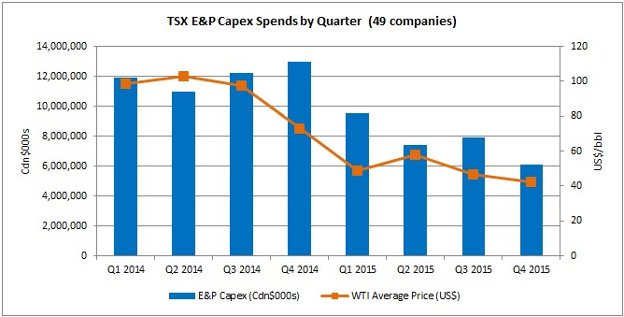In light of the commodity price downturn that began in 2014, almost every oil and gas company in Canada cut spending in 2015, with focus quickly switching from large scale development of properties to eliminating non-critical expenditures and merely sustaining production as much as possible to survive in the low price environment. But just how big were these cuts?
New analysis of annual results from CanOils shows that 49 TSX-listed oil and gas producers reduced their annual upstream spending by an average of 36% in 2015 as they sought to deal with consistently lower commodity prices compared with a year earlier. The total combined upstream spending (see note 1) over the whole of 2015 for these 49 TSX-listed E&P companies that had reported their annual capex spends for 2015 as of March 15, 2016 was Cdn$30.9 billion, compared to Cdn$48.1 billion in 2014.

Source: CanOils (see notes 1, 2 and 3)
Juniors Cut Spending to a Greater Extent than Larger Producers
Of course, the biggest producers on the TSX will have a greater impact on the above chart than smaller companies, as they have spent much larger sums over the past two years. To get a clearer look at how the upstream companies on the TSX have adjusted their spending patterns in light of the oil price downturn, we have split the companies into three distinct peer groups: Senior Producers (companies that produce over 100,000 boe/d), Intermediate Producers (between 10,000-100,000 boe/d) and Junior Producers (under 10,000 boe/d) – see note 4. Again, the combined spending in Cdn$ of each group is plotted in the charts below alongside the WTI price in US$.

Source: CanOils (see notes 1, 2 and 3)
It is interesting to note the delay in the reaction time to the falling price. When the price downturn had really started to take hold during Q4 2014, all three peer groups actually increased their spending from Q3 2014 levels; the senior and intermediate peer groups actually recorded their highest combined quarterly spends over the past two years in Q4 2014, when the oil price was rapidly moving in the other direction. Presumably, cash that was long-committed into certain projects and could not be reallocated, and the time taken to identify and then implement a new strategy away from non-essential spending both played a role in this delayed reaction. Also, it was highly uncertain whether or not lower prices would be a long term issue at the start of the downturn, with many companies not having an immediate need to react by cutting production or spending at all.













Leave A Comment